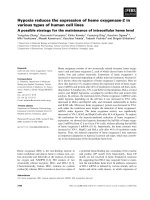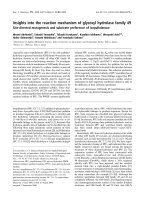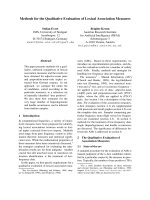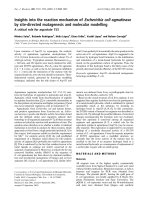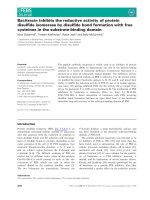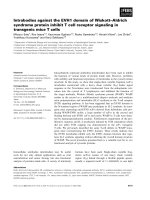Báo cáo khoa học: "Search in the Lost Sense of “Query”: Question Formulation in Web Search Queries and its Temporal Change" pptx
Bạn đang xem bản rút gọn của tài liệu. Xem và tải ngay bản đầy đủ của tài liệu tại đây (209.42 KB, 6 trang )
Proceedings of the 49th Annual Meeting of the Association for Computational Linguistics:shortpapers, pages 135–140,
Portland, Oregon, June 19-24, 2011.
c
2011 Association for Computational Linguistics
Search in the Lost Sense of “Query”: Question Formulation in Web Search
Queries and its Temporal Changes
Bo Pang Ravi Kumar
Yahoo! Research
701 First Ave
Sunnyvale, CA 94089
{bopang,ravikumar}@yahoo-inc.com
Abstract
Web search is an information-seeking activ-
ity. Often times, this amounts to a user seek-
ing answers to a question. However, queries,
which encode user’s information need, are
typically not expressed as full-length natural
language sentences — in particular, as ques-
tions. Rather, they consist of one or more text
fragments. As humans become more search-
engine-savvy, do natural-language questions
still have a role to play in web search?
Through a systematic, large-scale study, we
find to our surprise that as time goes by, web
users are more likely to use questions to ex-
press their search intent.
1 Introduction
A web search query is the text users enter into the
search box of a search engine to describe their infor-
mation need. By dictionary definition, a “query” is
a question. Indeed, a natural way to seek informa-
tion is to pose questions in a natural-language form
(“how many calories in a banana”). Present day web
search queries, however, have largely lost the orig-
inal semantics of the word query: they tend to be
fragmented phrases (“banana calories”) instead of
questions. This could be a result of users learning
to express their information need in search-engine-
friendly forms: shorter queries fetch more results
and content words determine relevance.
We ask a simple question: as users become
more familiar with the nuances of web search,
are question-queries — natural-language questions
posed as queries — gradually disappearing from the
search vernacular? If true, then the need for search
engines to understand question-queries is moot.
Anecdotal evidence from Google trends suggests
it could be the opposite. For specific phrases, one
can observe how the fraction of query traffic con-
taining the phrase
1
changes over time. For instance,
as shown next, the fraction of query traffic contain-
ing “how to” has in fact been going up since 2007.
However, such anecdotal evidence cannot fully
support claims about general behavior in query for-
mulation. In particular, this upward trend could
be due to changes in the kind of information users
are now seeking from the Web, e.g., as a result of
growing popularity of Q&A sites or as people en-
trust search engines with more complex information
needs; supporting the latter, in a very recent study,
Aula et al. (2010) noted that users tend to formu-
late more question-queries when faced with difficult
search tasks. We, on the other hand, are interested in
a more subtle trend: for content that could easily be
reached via non-question-queries, are people more
likely to use question-queries over time?
We perform a systematic study of question-
queries in web search. We find that question-queries
account for ∼ 2% of all the query traffic and ∼ 6%
of all unique queries. Even when averaged over in-
tents, the fraction of question-queries to reach the
1
www.google.com/intl/en/trends/about.html
135
same content is growing over the course of one year.
The growth is measured but statistically significant.
The study of long-term temporal behavior of
question-queries, we believe, is novel. Previous
work has explored building question-answering sys-
tems using web knowledge and Wikipedia (see Du-
mais et al. (2002) and the references therein). Our
findings call for a greater synergy between QA and
IR in the web search context and an improved un-
derstanding of question-queries by search engines.
2 Related work
There has been some work on studying and exploit-
ing linguistic structure in web queries. Spink and
Ozmultu (2002) investigate the difference in user
behavior between a search engine that encouraged
questions and one that did not; they did not explore
intent aspects. Barr et al. (2008) analyze the occur-
rence of POS tags in queries.
Query log analysis is an active research area.
While we also analyze queries, our goal is very dif-
ferent: we are interested in certain linguistic aspects
of queries, which are usually secondary in log anal-
ysis. For a comprehensive survey on this topic, see
the monograph of Silvestri (2010). There has been
some work on short-term (hourly) temporal analysis
of query logs, e.g., Beitzel et al. (2004) and on long
queries, e.g., Bendersky and Croft (2009).
Using co-clicking to infer query-query relation-
ships was proposed by Baeza-Yates and Tiberi
(2007). Their work, however, is more about the
query-click graph and its properties. There has also
been a lot of work on query clustering by common
intent using this graph, e.g., Yi and Maghoul (2009)
and Wen et al. (2002). We focus not on clustering
but on understanding the expression of intent.
3 Method
We address the main thesis of the work by retrospec-
tively studying queries issued to a search engine over
the course of 12 consecutive months.
Q-queries. First we define a notion of question
queries based on the standard definition of questions
in English. A query is a Q-query if it contains at
least two tokens and satisfies one of the following
criteria.
(i) Starts with one of the interrogative words, or
Q-words (“how, what, which, why, where, when,
who, whose”).
(ii) Starts with “do, does, did, can, could, has,
have, is, was, are, were, should”. While this ensures
a legitimate question in well-formed English texts,
in queries, we may get “do not call list”. Thus, we
insist that the second token cannot be “not”.
(iii) Ends with a question mark (“?”).
Otherwise it is a Q-query. The list of key-
words (Q-words) is chosen using an English lexi-
con. Words such as “shall” and “will”, even though
interrogative in nature, introduce more ambiguity
(e.g., “shall we dance lyrics” or “will smith”) and
do not account for much traffic in general; discard-
ing such words will not impact the findings.
Co-click data on “stable” URLs. We work with the
set of queries collected between Dec 2009 and Nov
2010 from the Yahoo! querylog. We gradually refine
this raw data to study changes in query formulation
over comparable and consistent search intents.
1. S
all
consists of all incoming search queries af-
ter preprocessing: browser cookies
2
that correspond
to possible robots/automated queries and queries
with non-alphanumeric characters are discarded; all
punctuations, with the exception of “?”, are re-
moved; all remaining tokens are lower-cased, with
the original word ordering preserved.
2. C
all
consists of queries formulated for similar
search intent, where intent was approximated by the
result URL clicked in response to the query. That is,
we assume queries that lead to a click on the same
URL are issued with similar information need. To
reduce the noise introduced by this approximation
when users explore beyond their original intent, we
focus on (query, URL) pairs where the URL u was
clicked from top-10 search results
3
for query q.
3. U
c50
Q
is our final dataset with queries grouped
over “stable” intents. First, for each month m, we
collect the multiset C
i
of all (q, u
i
) pairs for each
clicked URL u
i
, where the size of C
i
is the to-
tal number of clicks received by u
i
during m. Let
2
We approximate user identity via the browser cookie
(which are anonymized for privacy). While browser cookies
can be unreliable (e.g, they can be cleared), in practice, they are
the best proxy for unique users.
3
In any case, clicks beyond top-10 results (i.e., the first result
page) only account for a small fraction of click traffic.
136
U
(m)
be all URLs for month m. We restrict to
U =
m
U
(m)
. This set represents intents and con-
tents that persist over the 12-month period, allowing
us to examine query formulation changes over time.
We then extract a subset U
Q
of U consisting of
the URLs associated with at least one Q-query in
one of the months. Interestingly, we observe that
|U
Q
|
|U |
= 0.55: roughly half of the “stable” URLs are
associated with at least one Q-query!
Finally, we restrict to URLs with at least 50
clicks in each month to obtain reliable statistics later
on. U
c50
Q
consists of a random sample of such
URLs, with 423,672 unique URLs and 231M unique
queries (of which 21M (9%) are Q-queries).
Q-level. For each search intent (i.e., a click on u), to
capture the degree to which people express that in-
tent via Q-queries, we define its Q-level as the frac-
tion of clicks on u from Q-queries. Since we are
interested in general query formulation behavior, we
do not want our analysis to be dominated by trends
in popular intents. Thus, we take macro-average
of Q-level over different URLs in a given month,
and our main aim is to explore long-term temporal
changes in this value.
4 Results
4.1 Characteristics of Q-queries
Are Q-queries really questions? We examine 100
random queries from the least frequent Q-queries
in our dataset. Only two are false-positives: “who
wants to be a millionaire game” (TV show-based
game) and “can tho nail florida” (a local business).
The rest are indeed question-like: while they are not
necessarily grammatical, the desire to express the in-
tent by posing it as a question is unmistakable.
Still, are they mostly ostensible questions like
“how find network key”, or well-formed full-length
questions like “where can i watch one tree hill sea-
son 7 episode 2”? (Both are present in our dataset.)
Given the lack of syntactic parsers that are ap-
propriate for search queries, we address this ques-
tion using a more robust measure: the probability
mass of function words. In contrast to content words
(open class words), function words (closed class
words) have little lexical meaning — they mainly
provide grammatical information and are defined by
their syntactic behavior. As a result, most function
words are treated as stopwords in IR systems, and
web users often exclude them from queries. A high
fraction of function words is a signal of queries be-
having more like normal texts in terms of the amount
of tokens “spent” to be structurally complete.
We use the list of function words from Sequence
Publishing
4
, and augment the auxiliary verbs with
a list from Wikipedia
5
. Since most of the Q-words
used to identify Q-queries are function words them-
selves, a higher fraction of function words in Q-
queries is immediate. We remove the word used for
Q-query identification from the input string to avoid
trivial observations. That is, “how find network key”
becomes “find network key”, with zero contribution
to the probability mass of function words.
The following table summarizes the probabil-
ity mass of function words in all unique Q-
queries and Q-queries in U
c50
Q
, compared to two
natural-language corpora: a sample of 6.6M ques-
tions posted by web users on a community-based
question-answering site, Yahoo! Answers (Q
Y!A
),
and the Brown corpus
6
(Br). All datasets went
through the same query preprocessing steps, as well
as the Q-word-removal step described above.
Type Q-q Q-q Q
Y!A
Br
Auxiliary verbs 0.4 8.5 8.1 5.8
Conjunctions 1.2 1.4 3.4 4.5
Determiners 2.0 8.7 8.2 10.1
Prepositions 6.5 13.7 10.1 13.3
Pronouns 0.7 3.4 9.1 5.9
Quantifiers 0.1 0.7 0.4 0.6
Ambiguous 2.1 2.7 4.6 7.0
Total 12.9 39.0 43.9 47.1
Clearly, Q-queries are more similar to the two
natural-language corpora in terms of this shallow
measure of structural completeness. Notably, they
contain a much higher fraction of function words
compared to Q-queries, even though they express
similar search intent.
This trend is consistent when we break down by
type, except that Q-queries contain fewer conjunc-
tions and pronouns compared to Q
Y!A
and Br. This
happens since Q-queries do not tend to have com-
plex sentence or discourse structures. Our results
4
www.sequencepublishing.com/academic.html.
5
en.wikipedia.org/wiki/List_of_English_
auxiliary_verbs
6
khnt.aksis.uib.no/icame/manuals/brown/
137
suggest that if users express their information need
in a question form, they are more likely to express it
in a structurally complete fashion.
Lastly, we examine the length of Q-queries and
Q-queries in each multiset C
i
. If Q-queries con-
tain other content words in place of Q-words to ex-
press similar intent (e.g., “steps to publish a book”
vs. “how to publish a book”), we should observe a
similar length distribution. Instead, we find that on
average Q-queries tend to be longer than Q-queries
by 3.58 tokens. Even if we remove the Q-word and a
companion function word, Q-queries would still be
one to two words longer. In web search, where the
overall query traffic averages at shorter than 3 to-
kens, this is a significant difference in length — ap-
parently people are more generous with words when
they write in the question mode.
4.2 Trend of Q-level
We have just confirmed that Q-queries resemble
natural-language questions to a certain degree. Next
we turn to our central question: how does Q-level
(macro-averaged over different intents) change over
time? To this end, we compute a linear regression
of Q-level across 12 months, conduct a hypothesis
test (with the null hypothesis being the slope of the
regression equal to zero), and report the P -value for
two-tailed t-test.
As shown in Figure 1(a), there is a mid-range cor-
relation between Q-level and time in U
c50
Q
(corre-
lation coefficient r = 0.78). While the trend is
measured with slope = 0.000678 (it would be sur-
prising if the slope for the average behavior of this
many users were any steeper!), it is statistically sig-
nificant that Q-level is growing over time: the null
hypothesis is rejected with P < 0.001. That is, over
a large collection of intents and contents, users are
becoming more likely to formulate queries in ques-
tion forms, even though such content could easily be
reached via non-question-queries.
One may question if this is an artifact of using
“stable” clicked URLs. Could it be that search en-
gines learn from user behavior data and gradually
present such URLs in lower ranks (i.e., shown ear-
lier in the page; e.g., first result returned), which in-
creases the chance of them being seen and clicked?
This is indeed true, but it holds for both Q-queries
and Q-queries. More specifically, if we consider the
0.039
0.041
0.045
2 4 6 8 10 12
Q-level
month
slope = 0.000678
(a) Q-level
0.013
0.015
0.017
0.019
0.021
1 10 100 1000
average Q-rate
user activity level in a month
(b) Q-rate
Figure 1: Q-level for different months in U
c50
Q
; Q-rate
for users with different activity levels in S
all
.
rank of the clicked URL as a measure of search re-
sult quality (the lower the better), we observe im-
provements for both Q-queries and Q-queries over
time (and the gap is shortening). However, the av-
erage click position for Q-queries is consistently
higher in rank throughout the time. Thus, it is
not because the search engine is answering the Q-
queries better than Q-queries that users start to use
Q-queries more. While we might still postulate that
the decreasing gap in search quality (as measured
by click positions) might have contributed to the in-
crease in Q-level, if we examine the co-click data
without the stability constraint, we observe the fol-
lowing: an increasing click traffic from Q-queries
and an increasing gap in click positions between Q-
queries and Q-queries.
In addition, we also observe an upward trend for
the overall incoming query traffic accounted for by
Q-queries in S
all
(slope = 0.000142, r = 0.618,
P < 0.05). The upward trend in the fraction of
unique queries coming from Q-queries is even more
pronounced (slope = 0.000626, r = 0.888, P <
0.001). While this trend could be partly due to dif-
138
ferences in search intent, it nonetheless reinforces
the general message of increases in Q-queries usage.
This is also consistent with the anecdotal evidence
from Google trends (Section 1) suggesting that the
trends we observe are not search-engine specific and
have been in existence for over a year.
7
4.3 Observations in the overall query traffic
Note that in U
c50
Q
, Q-level averages ∼ 4%; recall
also for a rather significant portion of the web con-
tent, at least one user chose to formulate his/her in-
tent in Q-queries (
|U
Q
|
|U |
= 0.55). Both reflect the
prevalence of Q-queries. Is that specific to well-
constrained datasets like U
c50
Q
? We examine the
overall incoming queries represented in S
all
. On av-
erage, Q-queries account for 1.8% of query traffic.
5.7% of all unique queries are Q-queries, indicating
greater diversity in Q-queries.
What types of questions do users ask? The table
below shows the top Q-words in the query traffic;
“how” and “what” lead the chart.
word % word % word %
how 0.7444 what 0.4360 where 0.0928
? 0.0715 who 0.0684 is 0.0676
can 0.0658 why 0.0648 when 0.0549
do 0.0295 does 0.0294 are 0.0193
which 0.0172 did 0.0075 should 0.0072
How does the query traffic associated with differ-
ent Q-words change over time? We observe that all
slopes are positive (though not all are statistically
significant), indicating that the increase in Q-queries
happens for different types of questions.
Is it only a small number of amateur users who
persist with Q-queries? We define Q-rate for a given
user (approximated by browser cookie b) as the frac-
tion of query traffic accounted for by Q-queries. We
plot this against b’s activity level, measured by the
number of queries issued by b in a month. We binned
users by their activity levels on the log
2
-scale and
compute the average Q-rate for that bin. As shown
in Figure 1(b), relatively light users who issue up
to 30 queries per month do not differ much in Q-
rate on an aggregate level. Interestingly, mid-range
users (around 300 queries per month) exhibit higher
7
An explanation of why the upward trend starts at the end
of 2007 is beyond the scope of this work; we postulate that this
coincides with the rise in popularity of community-based Q&A
sites.
Q-rate than the light users. And for the most heavy
users, the Q-rate tapers down.
Furthermore, taking the data from the last month
in S
all
, we observe that for users who issued at least
258 queries, more than half of them have issued at
least one Q-query in that month — using Q-queries
is rather prevalent among non-amateur users.
5 Concluding remarks
In this paper we study the prevalence and charac-
teristics of natural-language questions in web search
queries. To the best of our knowledge, this is the
first study of such kind. Our study shows that ques-
tions in web search queries are both prevalent and
temporally increasing. Our central observation is
that this trend holds in terms of how people formu-
late queries for the same search intent (in the care-
fully constructed dataset U
c50
Q
). The message is re-
inforced as we observe a similar trend in the per-
centage of overall incoming query traffic being Q-
queries; in addition, anectodal evidence can be ob-
tained from Google trends.
We recall the following two findings from our
study. (a) Given the construction of U
c50
Q
, the up-
ward trend we observe is not a direct result of users
looking for different types of information, although
it is possible that the rise of Q&A sites and users
entrusting search engines with more complex infor-
mation needs could have indirect influences. (b) The
results in Section 4.2 suggest that in U
c50
Q
, Q-queries
receive inferior results than Q-queries (i.e., higher
average rank for clicked results for Q-queries for
similar search intents), thus the rise in the use of
Q-queries is not a direct result of users learning the
most effective query formulation for the search en-
gine. These suggest an interesting research question:
what is causing the rise in question-query usage?
Irrespective of the cause, given that there is an
increased use of Q-queries in spite of the seem-
ingly inferior search results, there is a strong need
for the search engines to improve their handling of
question-queries.
Acknowledgments
We thank Evgeniy Gabrilovich, Lillian Lee, D.
Sivakumar, and the anonymous reviewers for many
useful suggestions.
139
References
Anne Aula, Rehan M. Khan, and Zhiwei Guan. 2010.
How does search behavior change as search becomes
more difficult? In Proc. 28th CHI, pages 35–44.
Ricardo Baeza-Yates and Alessandro Tiberi. 2007. Ex-
tracting semantic relations from query logs. In Proc.
13th KDD, pages 76–85.
Cory Barr, Rosie Jones, and Moira Regelson. 2008. The
linguistic structure of English web-search queries. In
Proc. EMNLP, pages 1021–1030.
Steven M. Beitzel, Eric C. Jensen, Abdur Chowdhury,
David Grossman, and Ophir Frieder. 2004. Hourly
analysis of a very large topically categorized web
query log. In Proc. 27th SIGIR, pages 321–328.
M. Bendersky and W. B. Croft. 2009. Analysis of long
queries in a large scale search log. In Proc. WSDM
Workshop on Web Search Click Data.
Susan Dumais, Michele Banko, Eric Brill, Jimmy Lin,
and Andrew Ng. 2002. Web question answering: Is
more always better? In Proc. 25th SIGIR, pages 291–
298.
Mark Kr
¨
oll and Markus Strohmaier. 2009. Analyzing
human intentions in natural language text. In Proc.
5th K-CAP, pages 197–198.
Cody Kwok, Oren Etzioni, and Daniel S. Weld. 2001.
Scaling question answering to the web. ACM TOIS,
19:242–262.
Josiane Mothe and Ludovic Tanguy. 2005. Linguistic
features to predict query difficulty. In Proc. SIGIR
Workshop on Predicting Query Difficulty - Methods
and Applications.
Marius Pasca. 2007. Weakly-supervised discovery of
named entities using web search queries. In Proc. 16th
CIKM, pages 683–690.
Fabrizio Silvestri. 2010. Mining Query Logs: Turning
Search Usage Data into Knowledge. Foundations and
Trends in Information Retrieval, 4(1):1–174.
Amanda Spink and H. Cenk Ozmultu. 2002. Char-
acteristics of question format web queries: An ex-
ploratory study. Information Processing and Manage-
ment, 38(4):453–471.
Markus Strohmaier and Mark Kr
¨
oll. 2009. Studying
databases of intentions: do search query logs capture
knowledge about common human goals? In Proc. 5th
K-CAP, pages 89–96.
Ji-Rong Wen, Jian-Yun Nie, and Hong-Jiang Zhang.
2002. Query clustering using user logs. ACM TOIS,
20:59–81.
Jeonghee Yi and Farzin Maghoul. 2009. Query cluster-
ing using click-through graph. In Proc. 18th WWW,
pages 1055–1056.
140


